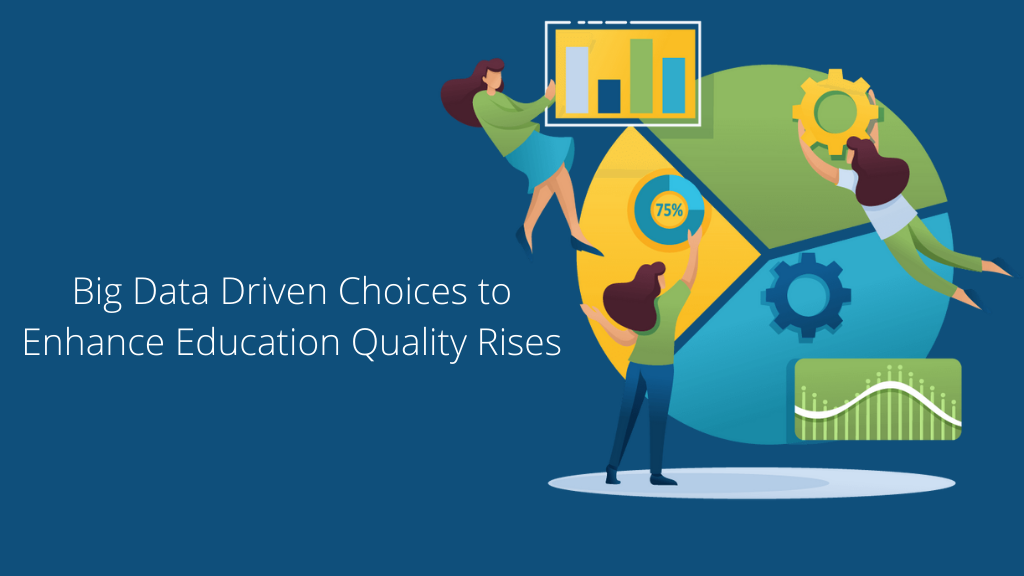Big Data Driven Choices to Enhance Education Quality Rises

As a result of the utilization of big data, there are significant changes occurring in the educational environment. There isn’t a single field of education that hasn’t been impacted by big data at some point. Student involvement and performance are monitored and managed in a variety of ways, including how educational institutions are regulated, how course quality is maintained, and how educational institutions are administered. When comparing the current educational system to the one that was previously in place, the changes represent a major paradigm shift in education. In the revolution, data is at the core of everything, and data is at the heart of everything. Big Data analytics solutions is helping educational institutions in enhancing the management of course quality, student performance and behavior, as well as the overall functioning of the institution. While some believe that such changes would result in better student recall of classroom instruction and a larger number of practical applications of the skills taught, others are skeptical.
According to the authors, the growing significance of data-intensive systems opens the door to new issues (and concerns) that are expected to play a significant role in the coming decade.
- The monitoring
(Big) When used in conjunction with a variety of tools and methods, data analytics enables a teacher to assess, monitor, and react to a student’s knowledge of a subject matter in real-time. Analytical tools that demonstrate how students learn may assist teachers in modifying their teaching methods and addressing the requirements of their students before the final grade is given. Our capacity to recognize and correct any unconscious biases we may have against the involvement or performance of our students will improve as a result of this development, which will help us as educators.
- Gaining new knowledge and experience
Make courses more interesting for students with a wide range of levels of knowledge and experience. Students at various levels of information acquisition Students in introductory courses may have different levels of basic knowledge, which may provide for an interesting and thought-provoking learning experience for the instructor. In order to offer different starting materials for dissimilar pupils within the same choices of course, it is necessary to do data analysis in order to identify where each student is failing or excelling. This will enhance student interest in the subject and will aid in determining who should get specific learning materials and when they should be distributed.
- Course construction
To quickly understand what the requirements of the company are while simultaneously developing a prospectus that fulfills those criteria is a tough challenge for businesses, colleges, and institutions. To analyze market and service trends, as well as to develop preliminary courses and basic cultural principles around new ideas and concepts, Big Data Analytics may be used in the business sector to benefit the organisation.
- Transform the educational system
Big data has a wide variety of applications and examples across a wide range of industries, but it seems to have the greatest potential to revolutionize education. In certain educational institutions, big data is a required component; yet, for many others, it is a novel idea that has been slow to adopt new technology in the recent past. Because it enables administrators, teachers, and students to track student progress and discover trends in student performance over time, big data is a very useful tool in any educational setting.
- Readily accessible
Inconvenient and time-consuming, searching through a disorganized, wall-to-wall arrangement of file cabinets is a common occurrence in offices. Because big data relies on a technological infrastructure to gather, store, and manage information, it is much easier to find what you are looking for when you utilize big data methods to collect, store, and manage information.
Additionally, information exchange may be hindered by the existence of institutional silos, which may occur alongside infrastructure issues. Leaders may have access to knowledge that instructors do not have, and this may provide obstacles in the growth and understanding of both pupils and teachers, respectively.
The use of data analytics, in conjunction with the right technologies, may help you in establishing a more collaborative work environment.
The bottom line:
Given the above, Research and Markets estimates that the global Big Data market was worth $32 billion in 2017 and is expected to rise to $156 billion by 2026, with a compound annual growth rate of 16%.
The majority of businesses, when adopting Big Data projects, do so with a number of specific goals in mind. However, while though most businesses’ primary goal is to enhance the customer experience, they also have a variety of additional goals like cost savings, better-targeted marketing, and increasing the efficiency of their existing processes. In recent years, data breaches have also brought attention to the need for better security, which is an objective that Big Data projects should aim to accomplish in their efforts.
Globalization has not only paved the way for greater competition in the global economy, but it has also fueled educational transformations all over the world, particularly in developing countries. When it comes to using Big Data analytics to extract value that can be utilized for the general benefit of the community, there is a strong passion among those in the education sector, and this excitement is gathering pace.






